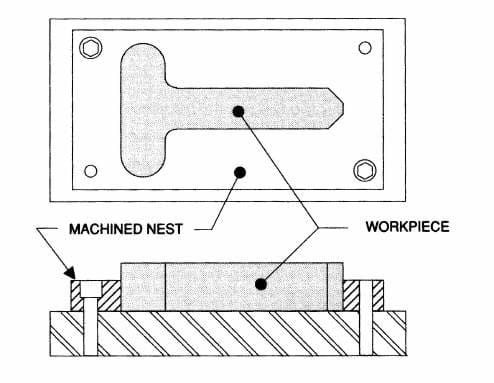Nesting locators are usually the most restrictive way to locate a workpiece. Typically, these locators are avoided due to their redundant location. However, for complex castings without a machined locating surface, nesting locators are sometimes the only choice.
Carr Lane Mfg. is recognized as a world leader for standard tooling components and industrial parts used by virtually every industry around the globe.
Known primarily for jig & fixture tooling components, Carr Lane Mfg. offers more than 100,000 industrial parts, including nesting locators.
What is a Nesting Locator?
A nesting locator either partially or completely encases the periphery of a workpiece. It may be machined, cast, or constructed with dowel pins. A machined nest, Figure 7-22, offers complete contact with the part but is usually very difficult to make.

Figure 7-22.
What Are Nesting Locators Used For?
A nesting locator completely locates the outside surfaces of a workpiece. It can be machined if the part shape is simple.
Cast nests are generally used for complex shapes or for nests that hold parts with irregular locating surfaces. In Figure 7-23, a nest is cast to suit the three-dimensional shape of the part.
Casting a nest requires either an epoxy-resin material or a low melting point alloy.
In either case, a cast nest conforms very well to even the most intricate part shapes. In addition, since the nest is cast, the time and expense involved is only a fraction of that to machine a nest.
 Figure 7-23.
Figure 7-23.
For irregular or complex shapes, a nesting locator can also be cast from plastic compounds or low melting point alloys.
It is generally best to make any nest separate from the tool body. The nest is then mounted to the tool body with screws and dowels. When the nest is part of the tool body, problems may result after the workholder begins to wear.
What are the Benefits of Nesting Locators?
If more than one nest is made at a time, the cost of replacing nests is greatly reduced. As the need arises to change the nest, a back-up nest is ready to mount on the workholder.
Although cylindrical rest buttons are the most common way of locating a workpiece from its external profile, other devices, including nesting locators, are also used for this purpose.
Locators Offered by Carr Lane Mfg.
Carr Lane Mfg. locators are designed to increase accuracy and positioning for various fixtures throughout the manufacturing process. Additionally, they come in a wide variety of sizes and shapes designed to best fit specific applications.
Carr Lane Mfg. is proud to manufacture & sell American-made locators, with most products made at either our St. Louis, MO plant or Austin, TX plant.